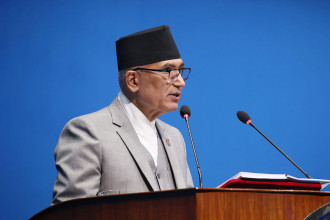
By Paresh Khetan
SAARC is a topic that has become increasingly frivolous and hopelessly redundant. In fact addressing the organisation as a topic is problematic; at this point it can be more accurately described as an issue. In 2015, after Nepal was hit by a series of devastating earthquakes, heads turned in every direction as the country sought aid to begin an immense humanitarian, and later, reconstruction project. The situation was somewhat assuaged as Nepal received close to $4 billion from more than 50 countries, and governmental, independent and relief organisations. Yet, amidst the catastrophe and the attempts to overcome it, SAARC was practically non-existent. Despite having a disaster management branch (SDMC) and claiming that dealing with natural disasters is a core area of cooperation, SAARC simply could not conjure up any meaningful action that is remembered today. Therefore, today it is no surprise that as another natural disaster takes its toll on the populace of South Asia, SAARC remains ineffective and uninvolved. The only message delivered from SAARC was on its website on August 14. It read, “The Secretary General of SAARC has expressed his sorrow and grief at the loss of lives and properties in Bangladesh, India and Nepal due to recent massive floods. He has expressed sincere condolences to the governments and people of these countries on the loss of precious lives and sympathised with those who have suffered injuries and damage to their property.” UN estimates state that close to 50 million people have directly been affected by the floods with 1288 deaths reported to date. Despite the horrific ongoing situation, the secretary simply made a press release “expressing his condolences.” Along with this, “he has expressed the hope that water will recede soon and the life of the people in the affected areas will return to normalcy.” The press release, as lackluster as it is, shows no indication towards cooperative action. If a regional bloc cannot convene to seek out a solution when a third of its states are in dire need, surely it must be considered a farce. Dr. Hemant Ojha, Distinguished Fellow and former Chair at South Asia Institute of Advanced Studies (SIAS), Kathmandu, said, “The region of SAARC is a global disaster hotspot. We experience major earthquakes almost every decade. History has clearly demonstrated the scale and frequency of earthquake risks in the Himalayas. The Nepal earthquake of 7.8 magnitude in 2015, which has been registered as the deadliest human catastrophe across the world for the year, led to 9000 human causalities. Floods are recurrent phenomena and every monsoon we experience floods in South Asia. Over 12 major rivers originate in the Himalayas and most of these pass through South Asia – except Sri Lanka. This past monsoon brought a major flood in Nepal, Eastern India and Bangladesh. Despite such repeated disaster events covering multiple countries in the region, there is limited SAARC level cooperation on tackling the challenge. SAARC cannot afford to ignore the severity of flood risks, as the predicted climate change alerts that the magnitude and severity of floods will only escalate in future. Since floods are caused by rivers crossing international borders, regional cooperation is absolutely essential to manage the risk. I would expect that SAARC take actions to set up knowledge sharing and risk monitoring platform at the very least, and then an institutional mechanism for early action and long term resilience building against floods in South Asia. This is possible given the level of human capacity that exists in the region, and also in view of the SAARC government’s financial capacity to invest.” Despite the obvious fragility of the region, the SAARC Disaster Management Center website has yet to release any news regarding the floods, let alone a response to it. Its news archive section has been “under the process of updation” since 2015. Furthermore, in such tumultuous times, SAARC Secretariat Director of Environment, Natural Disaster, and Biotechnology declined an interview. Criticising SAARC is like beating a dead dog and expecting any action; at a regional level it is expecting the dead dog to resurrect and assume a character it never once possessed. Therefore, it is more prudent to seek out potential actors and solutions within the vacuum that SAARC inaction has undoubtedly created. When asked “From Nepal’s perspective, should it start thinking about alternatives to SAARC?” Dr. Hemant Ojha said, “I think Nepal should continue to engage at the level of SAARC as well as at smaller sub-regional group levels. Two of the SAARC countries which Nepal should emphasise developing effective bilateral and trilateral cooperation are India and Bangladesh. Probably the most significant opportunity for Nepal is to secure uninterrupted transit access to Bangladeshi port via a trilateral agreement with India and Bangladesh. The agreement signed by India and Nepal on February 20, 2016 in this regard is an important achievement, and there is a need to build on this to develop a trilateral agreement involving Bangladesh. On environmental front too, cooperation among the three countries is a must. The fact that the three countries share river basins is an important context for their cooperation. Under the increasingly variable climate, rivers will bring more catastrophic floods across the region. Nepal should also look out to engage with the wider world beyond the region. Of special importance is the relationship with China, which has now emerged as the largest economy in the world. Nepal’s geography and culture has been exposed globally and there is a lot of interest across the world to cooperate with Nepal on diverse fronts – including environment, development, technology, and education. Nepal should not limit itself in the region but engage at all the three levels: sub-groups within SAARC, with SAARC and the wide world. This is even more important to build disaster resilience capacity in the face of persistent seismic risk and growing climate change induced environmental risks such as floods. “ Purushottam Ojha, former Secretary of Ministry of Commerce and Supplies, also had similar suggestions. When asked, “Do you think that the recent natural disasters are a missed opportunity for the region to unite? Is the lack of initiatives taken by SAARC a proof of its limits?” Ojha replied, “To an extent this is right. Of course, SAARC as a body could have utilised this opportunity, but leading up to those incidents SAARC was already off track. The 19th SAARC summit has not been held till date though it was supposed to be in 2015. Because the discussion of many important issues has been put off, countries are now inclined towards sub-regional and unilateral cooperation. While these areas of cooperation are advancing, SAARC has taken a back seat. So to answer your question, of course there are missed opportunities for brining the whole region to the forefront of development and economic cooperation. Now rather than focusing on SAARC, I believe it is the opportune moment to look for solutions through sub-regional cooperation. If you consider SAFTA (South Asian Free Trade Agreement) which was implemented in 2006 and aimed to complete the process of tariff liberalisation by 2016, you will notice that inter-regional trade is still very much low. Even 15 years back we would say it is low, around 5% and it is still hanging around 5% today. If we really want economic integration in the region, SAFTA must move ahead. The agreement has a lot of positives; it talks about connectivity, trade facilitation, customs cooperation, transit facilitation amongst many other things. Yet its implementation is wholly lacking. From the perspective of Nepal, there is no significant difference in the patterns of trade with neighboring countries. Even today, we maintain two-thirds of our trade with India and around 12% trade with China. Yet with Pakistan, which is the second biggest economy amongst SAARC countries we have minimal trade, as with Bangladesh. Furthermore, there is virtually no trade with Sri Lanka, Maldives, and Afghanistan. From 2006 till date, SAFTA has not influenced trade in Nepal in any significant way. In this regard, SAARC holds little value for Nepal. Over the past several years we have not been able to make progress in diversification of trade. So rather, we should think about whether we want to continue down such a road or move towards the bilateral track. BBIN holds a lot of prospects and also it is in our interest as we can get transit routes through Bangladesh. There is more value in pursuing BBIN rather than trying to fix SAFTA.” When asked, “What are some realistic duties SAARC can fulfill?” Ojha replied, “SAARC must continue its efforts to be a platform for dialogue, especially between India and Pakistan. Until these two countries make a strong commitment to constructive dialogue and move forward with a spirit of cooperation, the whole SAARC process is redundant. Without political commitment and dialogue we cannot move ahead. Also, SAARC as a body has provided a forum for the leaders of the member countries to meet each other, talk informally, especially about bilateral issues. Though these issues are not allowed to enter the arena of SAARC discussion, these sideline negations are important. As a political forum SAARC is okay, but its performance in the said areas of cooperation and its delivery at the people’s level has been poor. The body needs to revive or revamp itself so that it can deliver prosperity, cooperation, and concrete benefits to the people. For example, poverty reduction and coping with climate challenge issues amongst many others. If SAARC really wants to be fruitful for its people, it must prioritize issues rather than proliferating into a large number of areas which is not manageable. Without focus and setting priorities and a clarity of understanding, SAARC cannot move forward. “ Dr. Hemant Ojha also reiterated the need for the organisation to maintain and foster political ties. He said, “SAARC is not functioning well when compared to other regional cooperation experiences in the world. Yet, a few achievements are noteworthy. It has emerged as a platform for regional leaders to meet and discuss issues of common concern. Various regional agreements related to trade are a good step ahead, though formal agreements are not implemented well in practice. The establishment of regional centers on various aspects of development is seen as a good work of SAARC. The 11th SAARC Summit also established a regional commission for poverty alleviation. However, there is not enough level of commitment to implement these agreements in practice. Interstate disputes including on the potential of SAARC itself have limited the prospect of this regional platform.”
Published Date: November 20, 2017, 12:00 am
Post Comment
E-Magazine
RELATED Feature


-1761806697.jpg)
-1758006240.jpg)
-1752225714.jpg)
